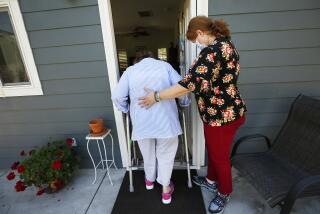Welfare Recipients Ask More Job Training
- Share via
Welfare recipients and advocates for the poor urged government officials on Friday to expand job training programs and work opportunities as a deadline approaches for many to get off public assistance.
“The problem is that people are getting part-time jobs, but they’re not getting out of poverty,” said Sam Mistrano, director of the Human Services Network, who helped organize the public hearing in a South Los Angeles church.
Many of the more than 300 assembled at Holman United Methodist Church said key changes are needed to ensure that welfare reform does not mean simply ripping the safety net from under the poor. In October, some welfare recipients who have not found jobs could become the first to lose their public aid for a year as part of the state reform program implemented in 1998.
But the group on Friday was preaching to politicians with similar beliefs. The panel of public officials--including Assembly Speaker Antonio Villaraigosa, City Councilwoman Jackie Goldberg and County Supervisor Yvonne Brathwaite Burke--have expressed the same concern that reform is merely kicking people off the dole, not putting them to work.
Most said they were troubled by statistics that show a growing gap between rich and poor, and indications that welfare reform is fueling the disparity. Goldberg cited studies claiming that Los Angeles has become simultaneously the richest and the poorest city in the nation, with the highest percentage of wealthy residents and 34% of the population living below the poverty line.
Leaders with the Welfare Reform Coalition, a group of about 250 social service organizations, said most of those who go off welfare find menial and part-time work that does little if anything to increase their standard of living. The group’s mission is to improve the state welfare-to-work program established last year, called CalWORKs.
While CalWORKs does some job training, “that is not the dominant approach,” according to Anthony Thigpenn of the welfare coalition, which sponsored the event.
A study by the Economic Roundtable, a nonprofit, public policy research organization, showed that the county welfare-to-work program is making significant strides in finding jobs, but that the majority of people remain in poverty. The group attributed that partially to the county’s emphasis on finding a job--any job--instead of going through skill development first. It urged shifting those priorities.
Zonia Cavazos, a single mother of three, agreed. Speaking in Spanish to the crowd, she said it would be more practical to go to school and learn English than to enter the county program, called Greater Avenues for Independence. “I had an experience at the county job training program,” she said. “I learned to dress right and fill out a job application. To me, that’s not a training program.”
The crowd boomed with laughter as others echoed her complaint. Priscilla Epps, 33, of Compton said she went on welfare during a bout of drinking after losing her boyfriend and her job as a receptionist. Her caseworker referred her to the work program, but she said it taught only enough skills to keep people on the bottom rung of employment.
But Louise Currie glowed about working for the city in Los Angeles’ welfare-to-work program. “I have four children and you don’t know how proud they are to say, ‘My mom works for the city,’ ” she said, choking up.
Job training needs to coincide with the types of jobs available, organizers said. And governments and the private sector need to work together to help create jobs.
The list of recommendations made by the coalition included reducing the caseload for social workers who deal with welfare recipients, increasing access to CalWORKs services, conducting appraisals of welfare families to determine what skills they may have, and better explaining the bureaucracy to people so they don’t accidentally lose their assistance.
Supervisor Burke said the welfare-to-work programs should also seek opportunities in home health care. “I know there are some women who don’t want to go to an office job,” she said.
Villaraigosa said that without significant policy changes, this push for welfare reform will create a “place out of Dickens’ storybook” where the destitute live next to the affluent. “Sixty-nine percent of the people on welfare are children,” he said. “What people don’t realize is that moving people from welfare to the streets is moving children from welfare to the streets.”
More to Read
Sign up for Essential California
The most important California stories and recommendations in your inbox every morning.
You may occasionally receive promotional content from the Los Angeles Times.











